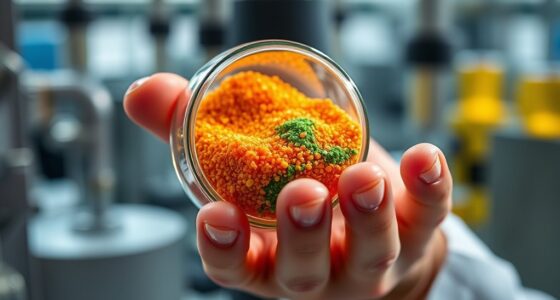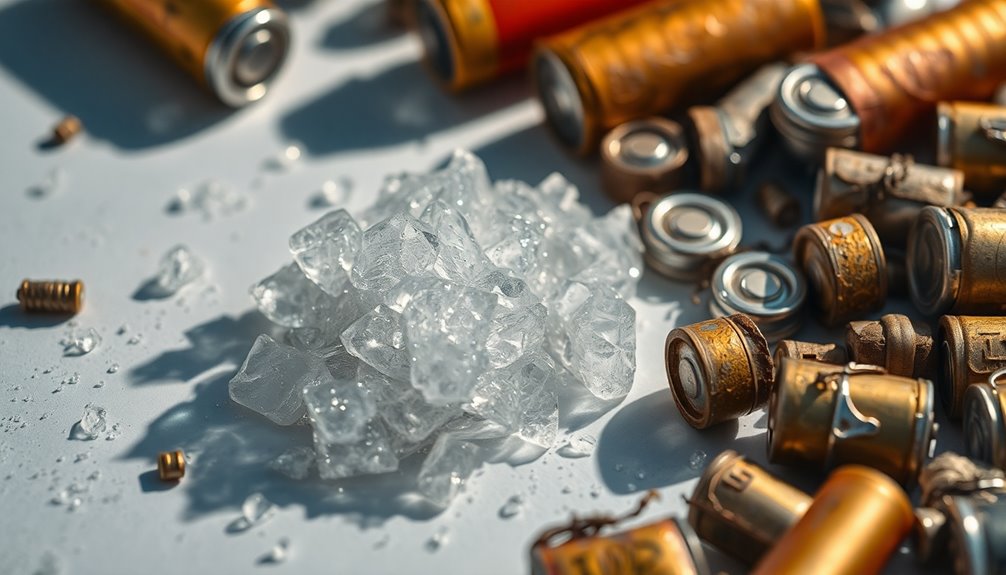Electrolytes in batteries are essential because they allow ions to move between electrodes, powering your devices. Liquid electrolytes, used in traditional lithium-ion batteries, enable fast ion flow but can be unsafe due to risks like leakage and thermal runaway. Solid electrolytes offer safer, more durable performance with higher energy density and reduced fire hazards. If you want to understand how these differences affect battery safety, capacity, and future technology, keep exploring these innovations.
Key Takeaways
- Electrolytes enable ion transfer, facilitating electrical flow within batteries, essential for device operation.
- Solid electrolytes offer improved safety, higher energy density, and support lithium metal anodes.
- Liquid electrolytes provide fast ion movement but pose risks like leakage, degradation, and thermal instability.
- Solid electrolytes are advancing toward commercial use, promising safer, more durable, and compact batteries.
- Both electrolyte types are crucial for evolving battery technology, balancing safety, performance, and longevity.

Have you ever wondered what makes batteries work? It all comes down to the electrolytes, the substances that facilitate the flow of ions between electrodes. These tiny particles carry electrical charge, enabling your devices to operate smoothly. In modern batteries, the debate often centers around solid versus liquid electrolytes, each with its unique advantages and challenges. Understanding these differences helps you grasp the innovations shaping energy storage today.
Solid state innovations are revolutionizing battery technology by replacing traditional liquid electrolytes with solid materials. These solid electrolytes can be ceramic, polymer, or glass-like substances that conduct ions efficiently. The key benefit here is safety; solid electrolytes are non-flammable, reducing the risk of fires associated with liquid electrolytes that can leak or ignite under stress. Additionally, solid-state batteries tend to have higher energy densities, meaning they can store more power in a smaller, lighter package—perfect for electric vehicles and portable electronics. Their design also allows for the use of lithium metal anodes, which further boosts capacity. As researchers develop better solid electrolytes with improved ionic conductivity and stability, we’re seeing rapid progress toward commercial applications. These innovations are not just making batteries safer but also more efficient and longer-lasting. Support hours and ongoing research are critical components in advancing these technologies.
On the other hand, liquid electrolyte stability remains a critical factor in battery performance. Traditional lithium-ion batteries rely on liquid electrolytes, usually a lithium salt dissolved in an organic solvent. While these liquids facilitate fast ion movement, they are sensitive to temperature changes and can degrade over time, leading to capacity loss. The stability of these liquids is essential for maintaining consistent performance and safety. Engineers have been working tirelessly to improve liquid electrolyte stability by developing new formulations that resist decomposition and thermal runaway. However, despite these efforts, liquid electrolytes still pose inherent risks, such as leakage or explosion if damaged. That’s why ongoing research aims to find a balance—improving liquid electrolyte stability enough to match the safety of solids while maintaining their high ionic conductivity.
In essence, both solid state innovations and enhanced liquid electrolyte stability are pushing the boundaries of battery technology. Solid electrolytes promise safer, more durable batteries with higher energy densities, while advances in liquid electrolyte stability aim to extend the lifespan and reliability of existing designs. As someone who relies on devices powered by batteries, these developments matter because they lead to safer, more efficient energy storage solutions. Whether through the growth of solid-state batteries or improved liquid electrolytes, the future of battery technology is set to deliver safer, longer-lasting power sources that keep your devices running smoothly and securely.
Frequently Asked Questions
How Do Electrolytes Affect Battery Lifespan?
Electrolytes directly impact your battery’s lifespan by influencing battery degradation and electrolyte stability. If the electrolyte breaks down or becomes unstable, it accelerates degradation, reducing capacity over time. Solid electrolytes generally offer better stability, slowing degradation, while liquid electrolytes may cause quicker deterioration due to leakage or side reactions. Choosing the right electrolyte type can profoundly extend your battery’s overall durability and performance.
Are Solid Electrolytes Safer Than Liquid Ones?
Like a fortress protecting its treasures, solid electrolytes are safer than liquid ones because they’re less likely to catch fire. They have better material stability, reducing fire hazards and leakage risks. Since they don’t contain flammable liquids, solid electrolytes offer enhanced safety, making them an excellent choice for devices where safety is paramount. Overall, their stability and fire resistance make them a smarter, safer option.
Can Electrolyte Type Influence Charging Speed?
Yes, electrolyte type can influence your charging speed. Solid electrolytes often have higher ion mobility, facilitating faster charge transfer, which can lead to quicker charging times. Liquid electrolytes typically offer better ion conduction at room temperature, but their stability limits speed. Choosing the right electrolyte depends on balancing safety, efficiency, and speed, with solid electrolytes potentially providing faster charging due to improved charge transfer capabilities.
What Environmental Impacts Do Electrolytes Have?
Electrolytes impact the environment through their sourcing and disposal processes. You should be aware that sustainable sourcing of materials reduces ecological harm, but recycling challenges, especially with liquid electrolytes containing hazardous chemicals, complicate waste management. Choosing eco-friendly electrolytes can lessen pollution and resource depletion, helping to minimize your environmental footprint. By supporting advances in recyclable and sustainable electrolytes, you contribute to a greener future for battery technology.
Are There New Electrolyte Materials in Development?
You’ll find that researchers are actively developing new electrolyte materials, focusing on solid state innovations that enhance electrolyte conductivity. These advancements aim to improve battery safety, energy density, and longevity. For example, solid electrolytes are being engineered from ceramics and polymers, offering better stability than liquids. By optimizing electrolyte conductivity, these new materials could revolutionize battery performance, making them more efficient and environmentally friendly for future energy storage solutions.
Conclusion
So, after all this, it’s funny how electrolytes—those tiny, overlooked components—can make or break your battery’s performance. Whether in solid or liquid form, they’re the unsung heroes or villains, depending on your needs. Ironically, the very thing that keeps your device running smoothly might also be the reason it eventually fails. Just remember, in the world of batteries, electrolytes are the real power players, even if they never get the spotlight.










